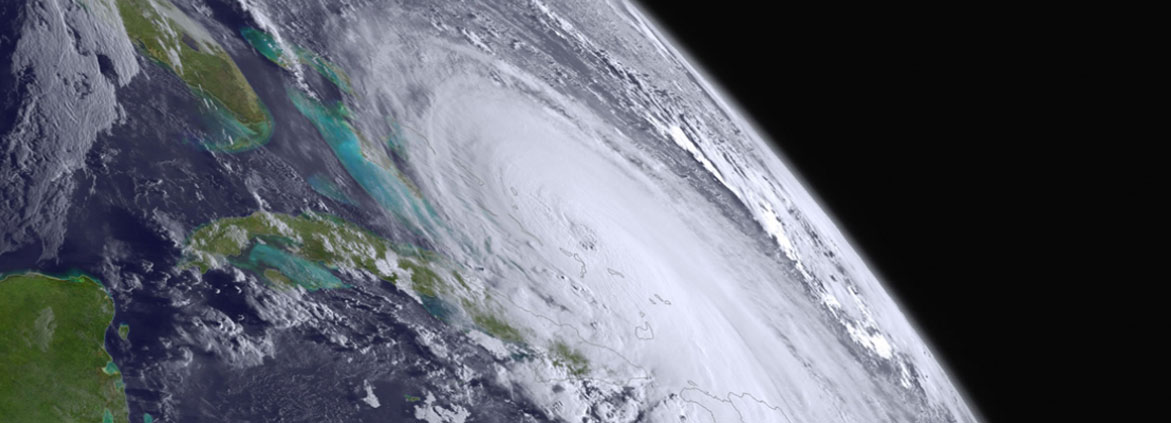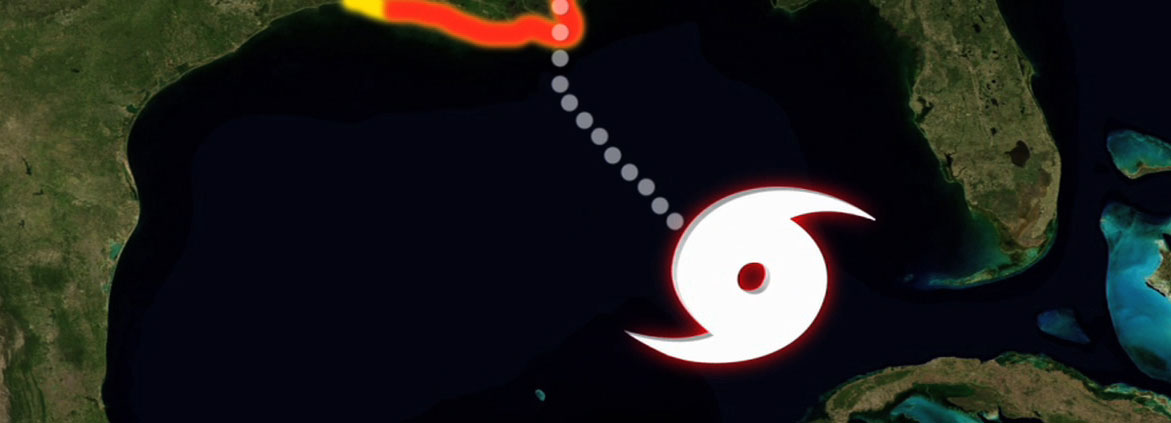Hurricanes
Preparedness, Response, Recovery
The National Ocean Service (NOS) brings a wealth of coastal science, management, and operational expertise to aid communities impacted by hurricanes in their recovery. We are on the front lines to help America understand, predict, and respond to the challenges facing our oceans and coasts. Learn about hurricanes and explore our roles and responsibilities related to hurricane preparedness, response, and recovery.
Top Links

Digital Coast: Coastal Storms
Coastal storms such as hurricanes and nor'easters bring flooding, storm surge, and the potential for severe damage. Communities that plan and prepare before a storm strikes are more resilient. These resources from NOAA's Digital Coast can help.
NOS Hurricane Preparedness, Response, and Recovery
Disaster Preparedness
NOAA's Disaster Response Center (DRC) enhances capacity to prepare for and respond to disasters. The DRC brings together NOAA-wide resources to prepare federal, state, and local decision makers for a variety of hazards and threats. The DRC hosts trainings, drills, and workshops to help Gulf communities prepare for storms while enhancing NOAA's coordination and emergency planning to conduct an organized and effective response.
Water-level Monitoring
The Center for Operational Oceanographic Products and Services monitors and disseminates observations of water levels, currents, and weather information in real time via the National Water Level Observation Network and the Physical Oceanographic Real-Time System. Collected real-time environmental information helps coastal authorities prepare for, mitigate, and respond to storm tides and coastal flooding. NOS also regularly updates Storm QuickLook, an online compilation of ocean and weather observations within a coastal area.
Water-level Monitoring Tools:
- Storm QuickLook
This website provides a synopsis of near real-time ocean and weather observations at specific water-level gauge locations affected by a tropical storm. - National Water Level Observation Network Real-time Data
Tide and weather observations are available in real-time at the more than 200 National Water Level Observation Network observation platforms located throughout the U.S., Pacific Islands, and Caribbean. - Sea Levels Online
This website provides trends for sea level rise, calculated using data collected at National Water Level Observation Network tide stations for more than 150 years. - Tidal Datums
This website provides tidal datums, which are standard elevations defined by a certain phase of the tide, for stations around the United States. - NOAA Tide Predictions
The NOAA Tide Predictions application provides astronomical tide prediction tables for the calendar year at water-level stations around the U.S., searchable by name, station ID, or latitude/longitude.
Ocean and Coastal Observations Data
NOAA coordinates the U.S. Integrated Ocean Observing System (IOOS®). This federal, regional, and private-sector partnership provides ocean and coastal data and information to support preparation and response efforts and to inform forecasts and predictions ahead of hurricanes. For example, the IOOS regions collect data inside the hurricane with unmanned, underwater robotic vehicles to increase understanding of hurricane intensity. In addition, radar systems measure surface current speed and direction as hurricanes pass through, to aid models and forecasts. IOOS is also partnering with National Weather Service (NWS) to make High Frequency radar data accessible through the NWS Advanced Weather Interactive Processing System and National Centers for Environmental Prediction data tanks. IOOS data helps decision makers protect our safety, economy, and environment.
Observations Data Tools:
- Physical Oceanographic Real-Time System (PORTS®)
Located in 18 ports around the U.S., this system measures and disseminates real-time observations and predictions of water levels, currents, salinity, and meteorological parameters (e.g., winds, atmospheric pressure, and air and water temperatures) needed for safe navigation. - Operational Forecast Systems
NOS operates hydrodynamic coastal oceanographic models that provide near-term forecasts of water levels, currents, salinity, and water temperature for a limited number of ports and estuaries in the United States. - U.S. Integrated Ocean Observing System
The U.S. Integrated Ocean Observing System (IOOS®) website provides links to regional IOOS websites where users can access ocean and coastal data and information before, during, and after hurricanes and other disasters.
Navigation Surveys
Immediately following a hurricane, the Office of Coast Survey provides emergency hydrographic services for affected port areas. These services are performed by Navigation Response Teams. These mobile emergency response units use echo sounders to check for submerged obstructions that pose hazards to vessels, collect data to update nautical charts, and provide mapping support. The work of these teams is essential to speeding the re-opening of ports and waterways.
Aerial Imagery Surveys
As soon as weather permits following major natural disasters, the National Geodetic Survey begins aerial survey missions to assess damages to affected areas. Typical weather-related events include hurricanes, tornadoes, and floods. NGS responds to other events, such as oil spills, as well. Directly georeferenced-imagery data are collected, rapidly processed, and made available via open-source Geographic Information Systems (GIS). These data and images provide emergency and coastal managers with information needed to develop recovery strategies, facilitate search and rescue efforts, identify hazards to navigation and HAZMAT spills, locate errant vessels, and provide documentation necessary for damage assessment through the comparison of before-and-after imagery. Images are also available to view and download by the general public as a tool to assess impacts to their homes and community.
Aerial Imagery Survey Tools:
- Emergency Response Imagery
The Emergency Response Imagery website access to aerial imagery such as photographs collected by NOAA aircraft following natural or human-made disasters. - Emergency Response Imagery Mobile Web App
This web application allows emergency responders and the public to quickly access images of disaster-impacted areas collected by NOAA aircraft using standard web browsers, iOS, or Android mobile devices.
Pollution Response
After a hurricane, the Office of Response and Restoration (OR&R) provides scientific support to hazardous materials response efforts in coastal areas. The office surveys vessels or containers that may be leaking fuel, oil, or other hazardous materials; flies missions to identify and document spill sources; and uses computer models to predict spill movement and determine pollution threats. OR&R also provides guidance on marine debris and vessel salvage, conducts shoreline cleanup assessments, collects information to understand natural resource impacts from spills in affected areas, and works to assess and restore resources injured by spills.
Pollution Response Tools:
- ERMA
The Environmental Response Management Application (ERMA®) is an online mapping tool that integrates both static and real-time data, such as Environmental Sensitivity Index (ESI) maps, ship locations, weather, and ocean currents, in a centralized, easy-to-use format for environmental responders and decision makers.
Contaminant Assessments
NOAA’s National Status and Trends (NS&T) Program, part of the National Centers for Coastal Ocean Science, coordinates with multiple partners to develop strategies to assess the environmental impacts of contaminants in coastal and estuarine waters in the aftermath of hurricanes. Of special concern is assessing the risk to human health of eating fish and shellfish and ensuring seafood safety.
Maps and Data Analysis
The Office of Response and Restoration's Environmental Response Management Application (ERMA®) integrates static and real-time data for science based decisions in one common operational picture for emergency response. Following a hurricane, the Office for Coastal Management provides the satellite and aerial images needed to generate maps that help officials understand the long-term effects of the hurricane. These data products include pre-hurricane imagery and digital elevation data from a variety of sources; before and after imagery comparisons; and maps depicting ecological impacts, debris assessment, and wetlands loss along the coast. The Center may also conduct studies that focus on a storm’s economic impacts.
Maps and Data Analysis Tools:
- Digital Coast
NOAA's Digital Coastal is an online access point for much of NOAA's data and tools that aid in hurricane recovery such as LIDAR data, coastal socio-economic and land use change data, Sea Level Rise and Coastal Flooding Impacts Viewer, and Environmental Sensitivity Index (ESI) maps.
Long-term Recovery Planning
The Office for Coastal Management provides assistance in long-term recovery planning in areas impacted by a hurricane. Staff may assist in the development of coastal project plans, coordinate with other federal and state organizations involved in recovery planning, and assist with the design and implementation of activities to involve local communities in planning for their own long-term recovery.
Recovery Tools:
- Historical Hurricane Tracks
The Historical Hurricane Tracks tool allows users to track local historical storm activity, review specific storm tracks, and obtain information about a particular storm's landfall.














